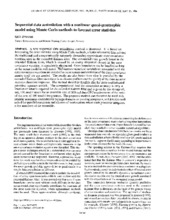| dc.contributor.author | Evensen, Geir | eng |
| dc.date.accessioned | 2008-11-18T09:55:05Z | |
| dc.date.available | 2008-11-18T09:55:05Z | |
| dc.date.issued | 1994-05-15 | eng |
| dc.Published | Journal of Geophysical Research: Oceans 1994;99(C5):10143-10162 | |
| dc.identifier.issn | 0148-0227 | |
| dc.identifier.uri | https://hdl.handle.net/1956/3035 | |
| dc.description.abstract | A new sequential data assimilation method is discussed. It is based on forecasting the error statistics using Monte Carlo methods, a better alternative than solving the traditional and computationally extremely demanding approximate error covariance equation used in the extended Kalman filter. The unbounded error growth found in the extended Kalman filter, which is caused by an overly simplified closure in the error covariance equation, is completely eliminated. Open boundaries can be handled as long as the ocean model is well posed. Well-known numerical instabilities associated with the error covariance equation are avoided because storage and evolution of the error covariance matrix itself are not needed. The results are also better than what is provided by the extended Kalman filter since there is no closure problem and the quality of the forecast error statistics therefore improves. The method should be feasible also for more sophisticated primitive equation models. The computational load for reasonable accuracy is only a fraction of what is required for the extended Kalman filter and is given by the storage of, say, 100 model states for an ensemble size of 100 and thus CPU requirements of the order of the cost of 100 model integrations. The proposed method can therefore be used with realistic nonlinear ocean models on large domains on existing computers, and it is also well suited for parallel computers and clusters of workstations where each processor integrates a few members of the ensemble. | en_US |
| dc.language.iso | eng | eng |
| dc.publisher | American Geophysical Union | eng |
| dc.subject | Oceanography | eng |
| dc.subject | Ocean modelling | eng |
| dc.title | Sequential data assimilation with a nonlinear quasi-geostrophic model using Monte Carlo methods to forecast error statistics | eng |
| dc.type | Journal article | eng |
| dc.identifier.doi | https://doi.org/10.1029/94jc00572 | |
| dc.subject.nsi | VDP::Matematikk og Naturvitenskap: 400 | nob |
